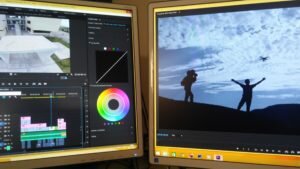 JCMS Teaching Dossier Vol 5 (3)
JCMS Teaching Dossier Vol 5 (3)
Not Another Brick in the Wall: The Audiovisual Essay and Radical Pedagogy
Travis McKenzie
Part 1: Concept development
“Interpretation in the digital age can be expressed in an act of construction.” —Mirko Tobias Schäfer
Like toddlers desperate to know how the world works (Piaget 1969), teenagers not only seek to understand their immediate environment, they have a natural curiosity about the world they cannot see (Engel 2011).
These inquiring minds want to know, and as much as we educators are employed to help, students are already using sites like YouTube to widen their knowledge, in what has been called a new type of classroom (García Jiménez et al. 2016).
There they search for information on everything from cinema theory to blacksmithing, music appreciation to philosophy, and it all takes place in an ecosystem where the most relevant and engaging content is voted to prominence by an audience of “prosumers” who create their own content even as they give critical real-time feedback to each other (Ritzer et al. 2012).

Image by Gerd Altmann from Pixabay
And yet in our classrooms we often insist that students demonstrate their learning in summative and static forms of assessment.
Is it any wonder then that in Australia alone there has been a 40% decline in classroom engagement (Goss, Sonnemann, 2017), while at the same time “how-to” searches on YouTube grow 70% year over year (Gesenhues, 2015)?
In the Universal Design for Learning a clear argument is made that not only must our method of delivery change, but also the nature of our assessment tasks (Gordon, 2016). We need to give our students structured Inquiry based learning tasks that will stimulate their curiosity (van Schijndel, Jansen & Raijmakers 2018). These will transform our classrooms into knowledge-building communities in which an engaged group of individuals communicate, critique and create ideas together (Herrington & Herrington, 2006).
Enter the video essay.
Part 2: Pre-production
“Nearly one third of all teachers are highly stressed by the challenges of engaging and reengaging students in class.” —Peter Goss and Julie Sonnemann
I first used video essays as an assessment task in 2016 for a Year 11 Media Studies unit on how society embeds its values in its representations. At the time I was already presenting video essays as engaging exemplars in my instruction, and I worried that the discussion these videos generated in the classroom would not translate into the students’ written work. The solution was to let the act of construction become an act of analysis (Schäfer, 2011).
And the work spoke for itself.
The next year I set a video essay task for a Year 12 Media unit on how narrative cinema conveys ideology to society. Again, the work the students produced proved that something special was happening. My students had found their voice, and they weren’t just speaking to me.
These video essays not only achieved a higher standard than written work on the same topic, but they also proved to be invaluable revision tools. I would be hard pressed to make my class read two dozen essays to prepare for exams, but students loved our ‘screening’ days and eagerly re-watched the best at the end of the year.
More importantly, they actively sought feedback on their own work as a natural part of the process, showing early drafts of their scripts and rough edits to gauge how their arguments were developing.
It was clear that video essays were not only rich assessment tasks, but they were also a pedagogical approach called Authentic Learning (Herrington & Herrington, 2006).
It was also clear they could be used beyond the media classroom.
At the time I was about to teach a year 10 English unit called Adaptations. The key knowledge in this area of study is how a novel is transformed by its translation from text to the screen or stage—perfect for a video essay assessment. The whole English team took the leap with me and all our classes dove into the project with enthusiasm.
The results were again clear. Students who self-reported as being “not good at English” found their ideas flowing in a way they had never experienced before. But it wasn’t just the end products that convinced me this was powerful pedagogy; it was the way they had worked. We all know that the first draft of anything is shit (Samuelson, 1984) and we tell students over and over that good writing is rewriting. But in over fifteen years of teaching Media and English, I can tell you that the typical high school student is worried about only two things when it comes to final assessment: Word count and due date. Once they hit that magic number, it is save and submit time, quality be damned.
But making video essays is different.
Part 3: Production
“The medium is the message.” —Marshall McLuhan
First, to make a video essay, a student must write an outline of what they are going to narrate. This is an example of using writing to learn (Bean 1996) and a student can link their script to a list of visual examples they plan to show on the screen. I use a simple two column template of “What I will say” on the left and “What I will show” on the right. I have even discovered the value of suggesting some students record themselves ad-libbing their analysis on the fly, transcribing their words back into a script for further refinement. This stage is also the first point of peer feedback, which has been shown to have a powerful engaging and formative effect on their learning (Wilkinson et al. 2002).
Modern media creation is becoming more complex, with a non-linear collaborative workflow (Lindstedt et al. 2009). and we should embrace this in our classrooms. So, as soon as a student has written even one clearly analysed idea, I recommend they jump from their planning script into a video editing program. This can be the part where some teachers panic.
So keep it simple. Video essays rely on only three things. A computer, audio-visual content and editing software. This is fine for media educators, but English teachers can balk at this step with cries of “I’m so bad with technology.”
Let them play. Let them explore and work it out together. It is a process that has been called Dynamic Assessment, and is directly linked to keeping students in Vygotsky’s Zone of Proximal Development (Shabani et al. 2010).
All you really have to do is point them to the right tools.
I have my own preferred programs and hardware to work with, and here are my suggestions broken up into Sound, Vision, Editing and Troubleshooting.
Sound
A voice recorder app on any current phone is the most consistent way for a student to capture their narration track. The hardest part about recording audio with a smartphone is the often-dumb process of transferring the files to a proper computer.

Image by Csaba Nagy from Pixabay
Vision
For a film or media analysis task, a student will obviously need access to a digital file of the media they are studying. Remember the magic terms educational and fair use. These video essays are for the classroom, not YouTube monetisation.

Image by PDPics from Pixabay
If you want your class to make non-film-theory video essays, such as book reviews or comparison text analysis, then covers of the novels, photos of the authors, or scanned pages of the texts can create engaging visuals to accompany their narration. There are also a host of public domain and royalty-free video content that students can access.
Editing
Once an audio track has been recorded and video content procured, students can start to put everything together using an open source program like Shotcut, or iMovie and Windows Movie maker that come installed with most laptops. There are, of course, premium packages like Adobe Premiere or Final Cut yet all will do for the task of making a video essay.

Image by mchiroque from Pixabay
I have found that as the students begin this phase of production, some realise they have not yet really clarified their essay thesis. It is therefore a great time to explicitly teach how to nominalise verbs or go back over their topic sentences and how they link to the main question. And, if all has gone according to plan, they will now be engaged enough to pay attention.
This engagement is the open door to powerful learning, where explicit instruction and worked examples can have their highest impact (DET 2017).
Troubleshooting
Problems are inevitable in a complex workflow and your students are going to come to you wanting to know how to crossfade a transition or export their files in full HD. This is where you will say the following words: Have you done a search for that?

Image by Lukas Bieri from Pixabay
This is not a cop-out. Remember where we began. Almost all experts in video editing learned through online video tutorials, and modelling this process is an integral part of the apprenticeship system of learning (Collins et al. 1989). All you need do is encourage them to share the best tutorials with the rest of the classroom and not only will the problems be solved, but the community will strengthen as reciprocal bonds are formed.
Indeed, identify the budding film-makers in your group and give them the honour of being a deputy teacher. They will be uploading their own tutorials within the week and these more capable peers are your most powerful allies in the classroom (Vygotsky 1978).
Part 4: Distribution
“This finding suggests the importance of social pressures in motivating people.” —E. Katz and P.F Lazarsfeld
Video essays work because they encourage students to work and re-work together. Motivated by the reality of showing their finished videos to their peers, students will discover that their ideas only get better with formative feedback from their teachers and peers. (Glasson 2008) I have even seen this translate back into their written work.
From a shy Year 7 student who wrote a script she had her Spanish speaking father narrate, to a disengaged Year 10 student discussing the portrayal of violence in a Stephen King adaptation, or a high-achieving student deconstructing the representation of immigration in a Year 10 unit on journalism, students find that video essays give authenticity and purpose to a range of coursework and student abilities.
Recently, an autistic boy hesitant to even attempt Year 12 Media received a near-perfect score for his comparison of the ideological content between Dr. No and Colossal.
I have seen proud parents amazed by what their kids can do, but most importantly I have seen students beaming when their peers applaud their effort.
Video essays work. Let students make them.
References
Bean, J.C. 1996. Engaging Ideas. San Francisco: Jossey-Bass Publishers.
Birenbaum, M., K. Breuer, E. Cascallar, F. Dochy, Y. Dori, J. Ridgway, and R. Wiesemes and G. Nickmans (eds.). 2006. A Learning Integrated Assessment System. Educational Research Review UK.
Collins, A., J.S. Brown, and S.E. Newman. 1987. Cognitive Apprenticeship: Teaching the Crafts of Reading, Writing, and Mathematics. Champaign: University of Illinois.
Engel, S. 2011. Children’s Need to Know: Curiosity in Schools. Cambridge: Harvard Educational Review.
García Jiménez, Antonio, B.C. García, and María López. 2016. “Adolescents and Youtube: Creation, Participation and Consumption.” Revista Prisma Social 1 (May): 60–89. https://revistaprismasocial.es/article/view/1314.
Gesenhues, Amy. 2015. “YouTube “How To” Video Searches Up 70%, With Over 100 Million Hours Watched In 2015.” Search Engine Land. https://searchengineland.com/youtube-how-to-searches-up-70-yoy-with-over-100m-hours-of-how-to-videos-watched-in-2015-220773
Glasson, T. 2008. Improving Student Achievement: A Practical Guide to Assessment for Learning. Carlton South: Curriculum Corporation.
Goss, Peter and Julie Sonnemann. 2017. Engaging Students: Creating Classrooms that Improve Learning. Grattan Institute.
Herrington, Anthony, and Jan Herrington. 2006. Authentic Learning Environments in Higher Education. Hershey, PA: IGI Global.
Katz, E., and P.F. Lazarsfeld. 1955. Personal Influence: The Part Played by People in the Flow of Mass Communications. New York : Free Press of Glencoe: 27.
Lindstedt, Inger, Jonas Löwgren, Bo Reimer, and Richard Topgaard. 2009. Nonlinear News Production and Consumption: A Collaborative Approach. Computers in Entertainment 7 (3): article no. 42.
McLuhan, Marshall. 1964. Understanding Media: The Extensions of Man. New York: McGraw-Hill.
Meyer, Anne, David H. Rose, and David Gordon. 2014. Universal Design for Learning: Theory and Practice. Wakefield, MA: CAST Professional Publishing.
Piaget, J. and B. Inhelder. 1969. The Psychology of the Child. New York: Basic Books.
Ritzer, George, Paul Dean, and Nathan Jurgenson. 2012. “The Coming of Age of the Prosumer.” American Behavioral Scientist 56 (4): 379–398.
Samuelson, Arnold. 1984. With Hemingway: A Year in Key West and Cuba. New York: Random House.
Schäfer, Mirko Tobias. 2011. Bastard Culture!: How User Participation Transforms Cultural Production. Amsterdam: Amsterdam University Press.
Shabani, Karim, Mohamad Khatib, and Saman Ebadi. 2010. Vygotsky’s Zone of Proximal Development: Instructional Implications and Teachers’ Professional Development. English Language Teaching.
Tessa J. P. van Schijndel, Brenda R. J. Jansen & Maartje E. J. Raijmakers. 2018. Do individual differences in children’s curiosity relate to their inquiry-based learning? International Journal of Science Education 40 (9): 996–1015.
Victorian Department of Education and Training. 2017. High Impact Teaching Strategies. https://www.education.vic.gov.au/school/teachers/teachingresources/practice/improve/Pages/hits.aspx
Vygotsky, L. S. 1978. Mind in Society: the Development of Higher Psychological Processes. Cambridge, MA: Harvard University Press.
Wilkinson, I. and I. Fung. 2002. Small-group composition and peer effects. International Journal of Educational Research.
Useful Links
A presentation I gave to the Monash Symposium on Visual Essays
Video essay resource guide
Free stock footage site list
Free sound resources site list
Free video editor
A “how to make a video essay” video essay with a call to extend the form
An educator and published writer, Travis McKenzie has been working as an English, Media and Art teacher for sixteen years. He has a deep commitment to creativity, collaboration, and critical thinking and believes stories will save the world. A published author and writer for the AEU News magazine, Travis explores themes of posthumanism and artificial intelligence in his fiction, and reflects on his teaching in his column, The Less I Know. Currently leading the 7-10 English and VCE Arts & Technology Professional Learning Communities at Fitzroy High, Travis is actively engaged in the facilitation of High Impact Teaching Strategies across a wide range of subjects and year levels. Travis is on the education board of Australian Teachers of Media and in 2018 worked with the Victorian Curriculum Assessment Authority to refine the criteria used to assess students creative folios. This year he is developing a whole-school literacy policy and sees multimodal analysis as a key part of teaching and assessment.
